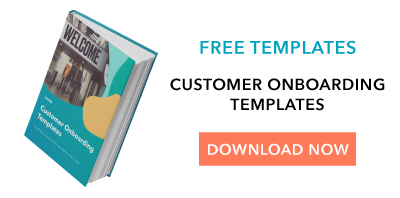Congratulations on signing up that new customer to work with. Now would be a good time to start preparing to kick off your service delivery and your approach to onboarding your new customer.
Everybody's heard of the analogies relating to getting off on the right foot first, and with new customer onboarding, this is an important analogy to appreciate. Typically, the implementation and adoption phase of a new product or software will set the foundations for the long-term success for the customer but also the speed in which a customer will achieve initial value on their investment.
I've onboarded HubSpot's very own customers for nearly three years, and one thing I've noticed is that preparation for and delivery of onboarding kickoff calls typically include the same five strategies if they are to be considered a successful first call with an excited and motivated new customer. In this post, I wanted to share with you these five strategies to use on new customer onboarding calls to help you get off on the right foot with your new customer and create that initial value.
5 Strategies for a Successful Onboarding Kick Off
1. Ensure a smooth sales handoff.
This one makes sense to be the first strategy on your list for your first onboarding strategies before a call with a new customer. From the customer's point of view, they have likely spoken at length with your sales team about their business and the reasons why they wanted to sign up to your product or service during the sales process. It makes sense for you to meet up with the sales representative to recap all of those pre-sale discussions to avoid asking the customer to repeat themselves to you about on your first onboarding call.
From your point of view, the sales team is very skilled at identifying some of the challenges and roadblocks that may have led to the customer coming to sign-up with your company. You should look to deep-dive, especially with the sales representative, to get their thoughts on these challenges to build your understanding on how to approach some of your own priorities with the implementation and priorities during the onboarding with the customer.
The insights gained from a quick catch-up coffee with your colleague in sales will be invaluable for your ability to effectively navigate your first onboarding call when it comes to parts of the call that relate to discovery and identifying first priorities.
2. Ask questions.
Question-asking is one of the biggest skills in your arsenal as an onboarding specialist, customer success manager, or in any other customer-facing role. For me, any onboarding call for which I feel that I've been doing all the talking feels like a less-than-successful call from my point of view, but also feel that this is the case for my customers.
If I break this strategy down a little bit more, effective question-asking will help you discover more about the customer and their goals, but from my point of view, you should already have a fairly complete picture of that coming out of the sales process and from your research before your first call. For me, question-asking should be an onboarding strategy that aims to build trust with your new customer.
One of the biggest benefits for a customer who is going through new product onboarding is having the chance to engage in communication with an expert who is there to help. Implementing a new piece of software of product can be a very daunting task, but targeting the human emotion of trust as an onboarding strategy as early as possible is one of the best things you can do for a new customer.
Asking the right questions about the customer is the easiest way to build rapport with a customer and show them that you understand their business and the challenges they face to build a strong foundation of trust and empathy.
3. Knowing your customer (and their team).
This point relates to relationship building with your main point of contact on the other side of the call, but also the strategy of uncovering the wider team working with your product. By identifying key stakeholders, along with your customer, you can build a clear picture of opportunities and roadblocks that could arise over the course of the business relationship.
It's a good idea to get a breakdown of the types of roles that will make up the part of the customer's team, which you can uncover on a kickoff call. Here are the types of roles to think about that will help you start on the path of building strong connections and knowing more about available resources on your customer's side:
Main Point of Contact: This is your go-to person throughout the onboarding process. They may be a primary user of the product and/or the project manager, and this the person to include in all customer communications.
Sponsor: The sponsor is typically the person who had sign off on the purchasing of the product coming over the course of the sales process. In some cases, this will be the main point of contact, but a lot of the time this person will be department manager or direct line manager of the Main POC.
Establish who this person is and have a plan to include them where possible in the onboarding. Your product renewal lies within this contact's power, most likely along with the influence of your main point of contact.
The Doers: If you are introduced by your main point of contact to a large team that each own parts of different strategies, they will likely make up the product users on a day-to-day basis. Think about any functional training as part of the onboarding for these users, training can be delivered directly to all users if your onboarding allows, or training the trainer with the main point of contact as the source of knowledge on the customer side.
Technical Resources: This may depend on your product, but there will likely be technical aspects of any product implementation, whether it's a SaaS product or a physical product. Understanding if your main point of contact has technical colleagues to assign specific implementation tasks to will be key to getting up and running quickly and correctly.
4. Uncover challenges.
Uncovering challenges is about identifying potential roadblocks during the onboarding process that could lead to struggles down the road. The kickoff call is a great time to note down any potential challenges or roadblocks that could crop up in the future. You can ask the customer to express their opinion on challenges they expect, but use your active listening to spot anything they aren't saying directly.
Dig into the amount of time they have set aside to work on the onboarding project as part of their day-to-day job, for example. Or, gauge the level of expertise your customer has with your product or if they have a clear strategy in mind already -- depending on these, the pace of your onboarding process may need to slow down.
5. Establish long-term goals.
I know this is one on your list of things to discuss on your kickoff call already, but let's look at what it means to establish long-term goals during this call.
One thing to pay attention to here is that long-term goals obviously differ from short-term goals and priorities. Asking the customer what their goals are will often result in an answer the customer has prepared for already, but if you listen closely to their answer, you can you spot if this goal is long-term, short-term, or just a priority they have. The onboarding plan you set out to work on with a customer may focus on their initial priorities, which is important as this will prove your initial value early on in the relationship. However, if you want to ensure long-term adoption or success after the onboarding call, understanding what the customer's long-term goals are is very important.
Sometimes as an onboarding specialist, you may need to push back on some of the customers' priorities and recommend a different approach or strategy. The only way to win their trust or approval is to reinforce the long-term goals of the company and to achieve results. If your customer success team involves handing over your customer to a colleague after onboarding, they will be working towards impacting the progress towards long-term goals.
With this in mind, it is your job as an onboarding specialist to make sure progress to date has been of benefit to long-term goals rather than working toward any other agenda.
I like to think of working to a customer's short-term goals as achieving quick wins and driving initial value as part of your onboarding service delivery -- but don't lose sight of the big picture. Make sure you're always actively listening to your customers and in close communication with your counterparts in sales and customer success to ensure a smooth transition with good results for your customer.
Next, learn more about the specifics of SaaS onboarding best practices.
Customer Onboarding









![10 Customer Onboarding Challenges You Might Face This Year [+Expert Tips]](https://53.fs1.hubspotusercontent-na1.net/hubfs/53/ai%20customer%20service%20predictions%20(2).webp)

![Digital Onboarding: How to Make It Work For You [+ 5 Helpful Tools]](https://53.fs1.hubspotusercontent-na1.net/hubfs/53/digital%20onboarding_featured%20image.jpg)
![Perfect your customer onboarding with our expert tips [+ checklist]](https://53.fs1.hubspotusercontent-na1.net/hubfs/53/client-onboarding-best-practices-1-20251029-7553263.webp)
.webp)